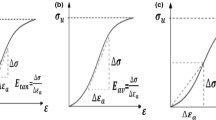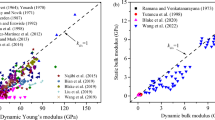Abstract
The relationship between the static and dynamic elastic modulus in rock materials has been frequently addressed in scientific literature. Overall, when it comes to the study of materials with a wide range of elastic moduli, the functions that best represent this relationship are non-linear and do not depend on a single parameter. In this study, the relationships between the static and dynamic elastic modulus of eight different igneous, sedimentary and metamorphic rock types, all of which are widely used as construction material, were studied. To this end, the elastic modulus values of 33 samples were obtained which, together with the values obtained for 24 other samples in a previous study, allowed a new relationship between these parameters to be proposed. Firstly, linear and nonlinear classical models were used to correlate static and dynamic moduli, giving R 2 of 0.97 and 0.99, respectively. A classical power correlation between static modulus and P-wave velocity has also been proposed, giving an R 2 of 0.99 and a sum of the squared differences (SSE) of 553.93. Finally, new equations relating static and dynamic modulus values have been proposed using new nonlinear expressions. These consider: (a) bulk density (R 2 = 0.993 and SSE = 362.66); (b) bulk density and total porosity of rock (R 2 = 0.994 and SSE = 332.16); and (c) bulk density, total porosity of rock and uniaxial compressive strength (R 2 = 0.996 and SSE = 190.27). The expressions obtained can be used to calculate the static elastic modulus using non-destructive techniques, in a broad range of rock materials.











Similar content being viewed by others
References
AENOR (2005) UNE-EN 14579. Métodos de ensayo para piedra natural. Determinación de la velocidad de propagación del sonido. Asociación Española de Normalización y Certificación, Madrid
AENOR (2007) UNE-EN 1936: Métodos de ensayo para piedra natural. Determinación de la densidad real y aparente y de la porosidad abierta y total, vol 1. Asociación Española de Normalización y Certificación, Madrid
Al-Shayea NA (2004) Effects of testing methods and conditions on the elastic properties of limestone rock. Eng Geol 74:139–156. doi:10.1016/j.enggeo.2004.03.007
Ameen MS, Smart BG, Somerville JM, Hammilton S, Naji NA (2009) Predicting rock mechanical properties of carbonates from wireline logs (a case study: Arab-D reservoir, Ghawar field, Saudi Arabia). Mar Pet Geol 26:430–444
Assefa S, McCann C, Sothcott J (2003) Velocities of compressional and shear waves in limestones. Geophys Prospect 51:1–13
Benavente D, García del Cura MA, Bernabéu A, Fort A, La Iglesia A, Ordóñez S (2005) Use of the microcrystalline limestone as building material: the “Gris Pulpis” case. Materiales de Construcción 55:5–23
Benson P, Meredith P, Platzman E, White R (2005) Pore fabric shape anisotropy in porous sandstones and its relation to elastic wave velocity and permeability anisotropy under hydrostatic pressure. Int J Rock Mech Min Sci 42:890–899
Brotons V, Ivorra S, Martínez-Martínez J, Tomás R, Benavente D (2013) Study of creep behavior of a calcarenite: San Julián´s stone (Alicante). Materiales de Construcción 63:581–595. doi:10.3989/mc.2013.06412
Brotons V, Tomás R, Ivorra S, Grediaga A (2014) Relationship between static and dynamic elastic modulus of a calcarenite heated at different temperatures: the San Julián’s stone. Bull Eng Geol Environ 73:791–799. doi:10.1007/s10064-014-0583-y
Budiansky B, Oconnell RJ (1976) Elastic-moduli of a cracked solid. Int J Solids Struct 12:81–97. doi:10.1016/0020-7683(76)90044-5
Ciccotti M, Mulargia E (2004) Differences between static and dynamic elastic moduli of a typical seismogenic rock. Geophys J Int 157:474–477. doi:10.1111/j.1365-246X.2004.02213.x
Christaras B, Auger F, Mosse E (1994) Determination of the moduli of elasticity of rocks. Comparison of the ultrasonic velocity and mechanical resonance frequency methods with direct static methods. Mater Struct 27:222–228. doi:10.1007/bf02473036
Dunham RJ (1962) Classification of carbonate rocks according to depositional texture. In: Ham WE (ed) Classification of carbonate rocks. American Association of Petroleum Geologists, Tulsa, pp 108–121
Eissa EA, Kazi A (1988) Relation between static and dynamic Young´s Moduli of rocks. Int J Rock Mech Min Sci 25:479–482. doi:10.1016/0148-9062(88)90987-4
García-del-Cura M, Benavente D, Martínez-Martínez J, Cueto N (2012) Sedimentary structures and physical properties of travertine and carbonate tufa building stone. Constr Build Mater 28:456–467
Guéguen Y, Palciauskas V (1994) Introduction to the physics of rocks. In: Press PU (ed). Princeton, New Jersey (EE.UU), p 294
Heap MJ, Faulkner DR (2008) Quantifying the evolution of static elastic properties as crystalline rock approaches failure. Int J Rock Mech Min Sci 45:564–573. doi:10.1016/j.ijrmms.2007.07.018
Heap MJ, Lavallee Y, Petrakova L, Baud P, Reuschle T, Varley NR, Dingwell DB (2014) Microstructural controls on the physical and mechanical properties of edifice-forming andesites at Volcan de Colima. Mex J Geophys Res Solid Earth 119:2925–2963. doi:10.1002/2013jb010521
Heap MJ, Xu T, Chen CF (2014) The influence of porosity and vesicle size on the brittle strength of volcanic rocks and magma. Bull Volcanol. doi:10.1007/s00445-014-0856-0
Horsrud P (2001) Estimating mechanical properties of shale from empirical correlations society of petroleum engineers. SPE. doi:10.2118/56017-pa
Ide JM (1936) Comparison of statically and dynamically determined young’s modulus of rocks. Proc Natl Acad Sci USA 22:81–92. doi:10.1073/pnas.22.2.81
ISRM (1979) Suggested method for determining the uniaxial compressive strength and deformability of rock materials. ISRM Suggest Methods 2:137–140
Jiang J, Sun J (2011) Comparative study of static and dynamic parameters of rock for the Xishan Rock Cliff Statue. J Zhejiang Univ Sci A 12:771–781. doi:10.1631/jzus.A1100003
King MS (1983) Static and dynamic elastic properties of rocks from the canadian shield. Int J Rock Mech Min Sci 20:237–241. doi:10.1016/0148-9062(83)90004-9
Kolesnikov YI (2009) Dispersion effect of velocities on the evaluation of material elasticity. J Min Sci 45:347–354
Lacy L (1997) Dynamic rock mechanics testing for optimized fracture designs. Paper SPE 38716 presented at the SPE annual technical conference and exhibition, San Antonio, 5–8 October
Martinez-Martinez J, Benavente D, Garcia-del-Cura MA (2011) Spatial attenuation: the most sensitive ultrasonic parameter for detecting petrographic features and decay processes in carbonate rocks. Eng Geol 119:84–95. doi:10.1016/j.enggeo.2011.02.002
Martinez-Martinez J, Benavente D, Garcia-del-Cura MA (2012) Comparison of the static and dynamic elastic modulus in carbonate rocks. Bull Eng Geol Environ 71:263–268. doi:10.1007/s10064-011-0399-y
Najibi AR, Ghafoori M, Lashkaripour GR (2015) Empirical relations between strength and static and dynamic elastic properties of Asmari and Sarvak limestones, two main oil reservoirs in Iran. J Pet Sci Eng 126:78–82
Nur A, Wang Z (1999) Seismic and acoustic velocities in reservoir rocks: recent developments. Society of Exploration Geophysicists, Tulsa
Palchik V, Hatzor Y (2002) Crack damage stress as a composite function of porosity and elastic matrix stiffness in dolomites and limestones. Eng Geol 63:233–245
Siratovich PA, Wyering LD, Villeneuve MC, Wallis IC, Kennedy BM, Gravley DM, Cant JL (2014) Mechanical and physical properties of hydrothermally altered rocks, Taupo Volcanic Zone, New Zealand. J Volcanol Geotherm Res 288:76–93. doi:10.1016/j.jvolgeores.2014.10.008
Vanheerden WL (1987) General relations between static and dynamic moduli of rocks. Int J Rock Mech Min Sci 24:381–385
Vergara L et al (2001) NDE ultrasonic methods to characterise the porosity of mortar. NDT E Int 34:557–562
Walsh JB, Lockner DA, Byerlee JD (1997) Changes in seismic velocity and attenuation during deformation of granite. J Geophys Res 82:5374–5378. doi:10.1029/JB082i033p05374
Acknowledgments
The authors acknowledge the financial support received from the Spanish National project of the Ministry of Economy and Competitiveness by the project BIA2012-34316, and the support of the Generalitat Valenciana by the project ACOMP/2014/289.
Author information
Authors and Affiliations
Corresponding author
Rights and permissions
About this article
Cite this article
Brotons, V., Tomás, R., Ivorra, S. et al. Improved correlation between the static and dynamic elastic modulus of different types of rocks. Mater Struct 49, 3021–3037 (2016). https://doi.org/10.1617/s11527-015-0702-7
Received:
Accepted:
Published:
Issue Date:
DOI: https://doi.org/10.1617/s11527-015-0702-7




